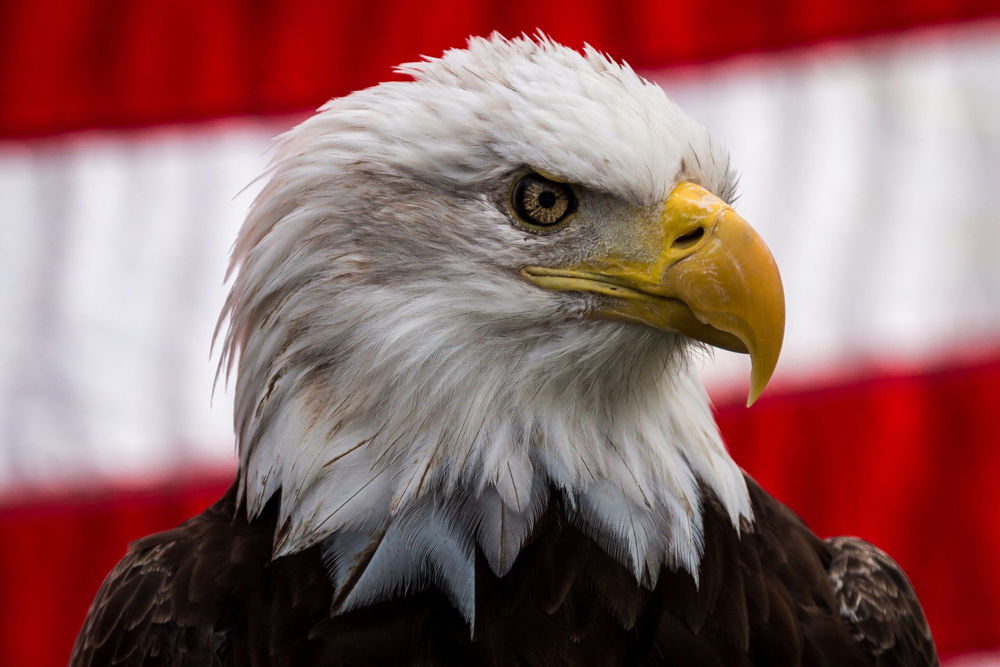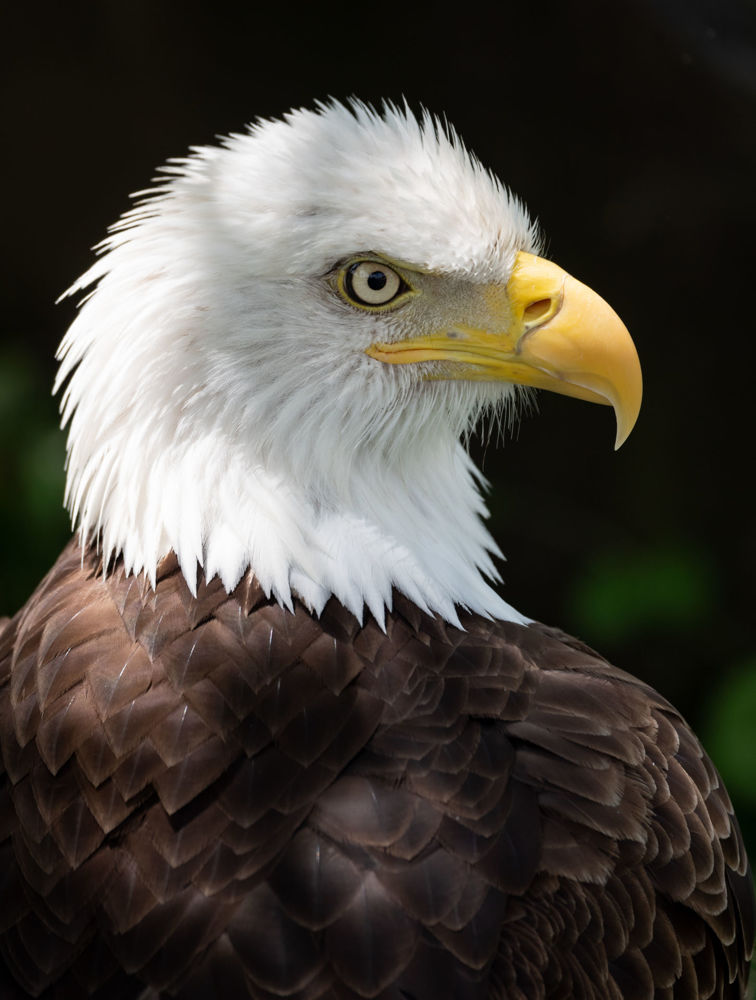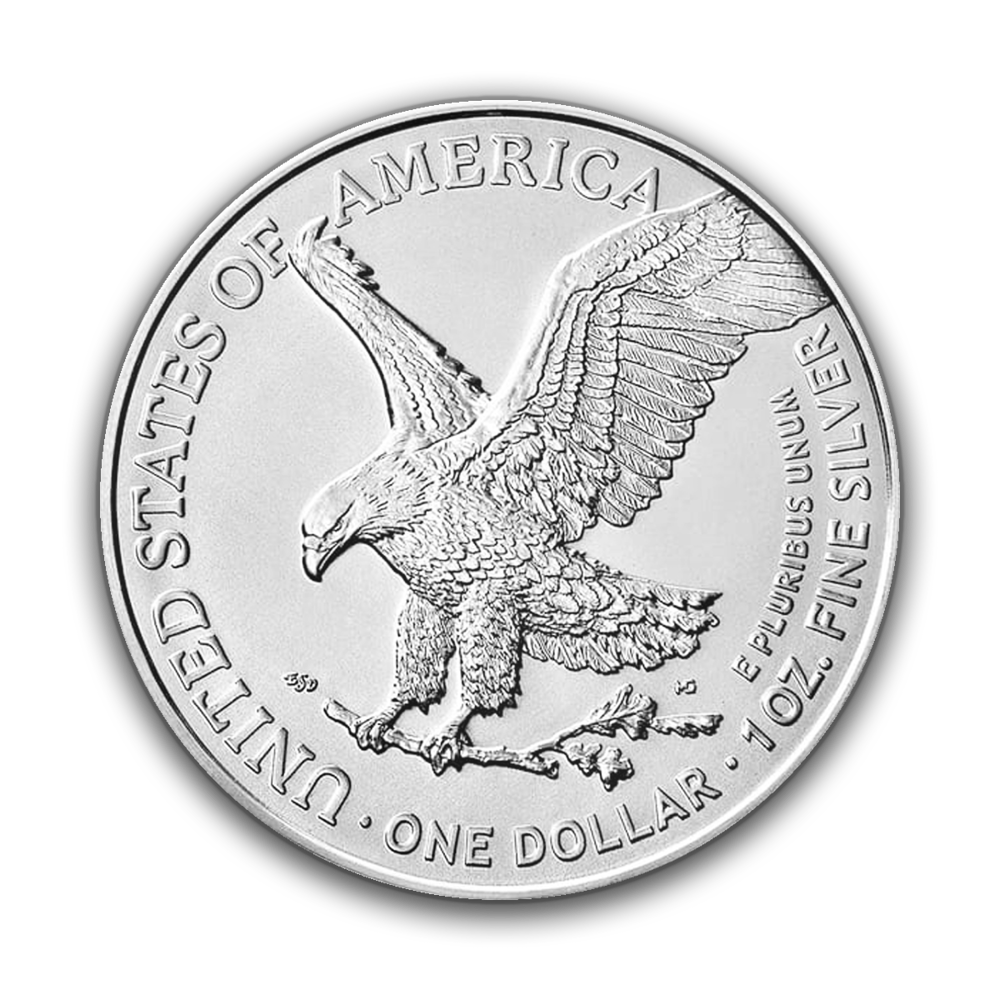Posted on March 22, 2022


Despite Benjamin Franklin’s critique of the bald eagle as “a bird of bad moral character,” the bald eagle has long been a symbol of enduring freedom in America.
The bald eagle has been the national bird of the nation since 1782 and has become a ubiquitous image in the United States, appearing on currency, the Seal of the President, the Mace of the House of Representatives, and other high-profile places. Few, if any, images bear a stronger association with American democracy than the bald eagle.
But when did the eagle become such an important figure in the U.S.? And how did it grow into the influential image in the American government and culture we know today?
The bald eagle – whose scientific name is Haliaeetus leucocephalus – is an eagle native to North America. The majority of these majestic birds reside in the United States, though you can also find bald eagles in Mexico and Canada. Bald eagles are large birds, and while at a maximum of nine pounds they don’t weigh very much (their skeletons are incredibly light, making them excellent fliers), they do boast an impressive wingspan ranging from just under six feet to well over seven feet.
Eagles mate for life and generally return, as a nesting pair, to the same nesting area or site each year during the breeding season. Eagles build large nests – also known as aeries – which measure roughly five feet wide, with some older nests growing to nearly 10 feet in diameter. Aeries are made of interwoven sticks lined with plants, moss, or grass.
They tend to add to their nests each year. The largest bald eagle nest on record, in Florida, was used for 30 years and weighed two tons when it finally fell from its host tree.
The bald eagle will often establish residence in the high branches of the tallest tree they can find near sizable bodies of water, where plenty of food is available for them (and easy to see).
The eagle is an opportunistic predator that hunts, steals, and scavenges. While bald eagles prefer to eat fish, they also hunt small birds and rodents and even feed on carrion (decaying flesh of dead animals). Eagles adapt to their situation and feed on whatever is around – dead or alive – favoring the catch that requires the lowest energy expenditure. Bald eagles are relatively indiscriminate about their food, eating virtually any animal they can kill, steal, or find.
A bald eagle’s diet consists primarily of fish (70 - 90%), though these birds will also hunt and eat squirrels, duck, and geese.
When hunting, eagles rely heavily on their eyes, a cunning intellect, and the element of surprise. Using its incredible eyesight (hence the term eagle eye), an eagle will circle the skies high above the ground or water, searching for tasty targets below. Once an eagle locates its mark, it can dive at up to 100 mph, surprising its prey with a swift, brutal attack of razor-sharp talons. Younger eagles are the primary hunters while older eagles are more likely to scavenge or steal their dinners.
Though the eagle is a feared predator in the skies, these birds are just as happy to enjoy a meal that someone else worked for, chasing other predators away from their kills and also eating plenty of carrion when given the chance.
 In the 1960s, bald eagles came dangerously close to becoming extinct, with only a few hundred surviving nesting pairs. When the eagle rose to fame in the United States in the late 19th century, its population numbered roughly 100,000.
In the 1960s, bald eagles came dangerously close to becoming extinct, with only a few hundred surviving nesting pairs. When the eagle rose to fame in the United States in the late 19th century, its population numbered roughly 100,000.
At some point during the 1800s, the eagle population reversed course, likely due to the explosion of the feather trade and high demand for virtually all bird feathers. In 1940, Congress passed the Bald Eagle Protection Act, making it illegal to sell, hunt, or possess eagles, their nests, feathers, eggs, and body parts. The only exception to this federal law is to enable Native Americans to continue their traditional, spiritual and cultural practices. Without this exception, an offense can lead to a fine of $250,000!
Unfortunately, the Bald Eagle Protection Act did not do enough to help the eagles’ cause. By the 1960s, the eagle population had plunged dramatically — their numbers reaching a record low in 1963. Over time, the eagles’ very existence was threatened by hunters, developers destroying their habitat, and most ominously the silent killer known as dichloro-diphenyl-trichloroethane (DDT).
DDT is a synthetic insecticide developed in the mid-1900s, which was banned by the Environmental Protection Agency (EPA) in 1972 due to its adverse impact on the environment, animals, and humans. As a result of consuming fish contaminated by DDT, the number of bald eagles plummeted, reaching an all-time low of just 417 known nesting pairs. DDT affected the shells of birds’ eggs, rendering them so brittle that nesting mother eagles often crushed their own eggs.
In 1973, the bald eagle was earmarked for protection under the Endangered Species Act, making it one of the first animals placed on this list. Five years later, in 1978, the bald eagle was officially listed as an endangered species in the lower 48 states.
After its close encounter with extinction and decades on the endangered species list, bald eagles staged a remarkable comeback. The number of eagles in North America slowly increased until, in 2007, the U.S. Fish and Wildlife Service announced that the bald eagle would actually be removed from the endangered species list. How often do you hear of that happening?
Despite being pulled from the endangered species list, the Bald eagle is still protected under the Bald and Golden Eagle Protection Act and other federal and state laws.
Today, bald conservation efforts continue to demonstrate their effectiveness. As of early 2021, there are an estimated 71,400 nesting pairs and 316,700 individual bald eagles in the lower 48 states. They can be spotted in the wild across the United States, though Alaska, Minnesota, Florida, Washington, and Oregon have the largest populations.
Thousands of years before the existence of the United States, the eagle was revered by the ancient Romans. The Romans regarded the eagle as the king of birds and a symbol of strength, courage, and immortality. Much like in the U.S. today, the ancient Romans proudly displayed the eagle as a national symbol, featuring the bird on its official seals and as the emblem of the Roman army.
As a physical Roman symbol, the eagle standard – known as an Aquila – was often affixed to a staff or spear and carried into battle. Akin to a deity, the figure of an Aquila was worshiped by ancient Roman legions as it gleamed atop a staff held by the top sergeant. For the Romans, being appointed the aquilifer (bearer of the Aquila) was considered one of the highest possible honors.
Roman soldiers fiercely protected these eagle standards, and a lost Aquila was treated with the utmost gravity. The Romans went to great lengths to recover a lost Aquila, even if that meant returning to battle or engaging in a years-long search. Legionary eagles were so prized by the Romans that, following the Battle of the Teutoburg Forest, the Roman army literally spent decades searching and fighting to recover a trio of lost Aquila. Only 11 Aquila are ever known to have been lost in battle; of those 11, six were recovered, while the fate of the remaining five remains uncertain to this day.
The significance of the eagle in Roman history doesn’t end with the legionary eagles. Charlemagne, the Holy Roman emperor, is said to have had an eagle, an animal symbolic of imperial power. Many people believe that Charlemagne’s adoption of the eagle as a symbol for freedom is the very reason the German coat of arms is highlighted by the bird.
If we look back earlier in history, the eagle’s significance predates even the ancient Roman period. In Ionia (present-day Turkey) and parts of the Greek and Macedonian empires, ancient coinage reveals images of the eagle dating back as far as 600 BC.
In the Native American tradition, the eagle, often represented simply by a feather, has long served as a symbol of courage, strength, wisdom, love, and more. Different Native American tribes attributed different qualities to the eagle, some of whom believed that the eagle offered a spiritual connection to the divine.
The eagle continues to enjoy its status as a popular symbol, often in the form of the golden eagle rather than the bald eagle. For many countries, the eagle is a symbol of strength and freedom. Nations across the globe, including Mexico, Egypt, Albania, Serbia, Kazakhstan, and Moldova, all feature an eagle prominently displayed on their flags. Another well-known example of an eagle as a national symbol is Germany’s federal eagle. The German coat of arms, with its distinct gold background, depicts the widely recognized black and red eagle.
 The American bald eagle and the United States
The American bald eagle and the United StatesAs we’ve seen, the United States is far from the first country to choose an eagle as its national symbol. However, the American bald eagle is specifically a New World species, totally separate from the golden and other eagles revered across Europe and Asia.
One of the first displays of an eagle in the United States dates back to a Massachusetts copper cent stamped in 1776. In 1782, Charles Thomson – the secretary of Congress – was tasked with helping design an official seal for the developing nation.
Thomson, who likely knew full well of the eagle’s rich historical status as a national symbol, suggested the original “white eagle” in an earlier proposed design by William Barton be replaced by an American bald eagle. Congress accepted Thomson’s bald eagle design, adopting it in June 1782.
Ten years after Thomson’s design was approved, the United States passed the Coinage Act of 1792, establishing a national currency and a government mint to create coins. The Coinage Act created several coins bearing the image of the new national bird. Among the first coins produced by the U.S. mint under this new act were the eagles, half eagles, and quarter eagles, all of which were made from gold.
Since the Coinage Act, the eagle has been a staple image featured on U.S. precious metal coins. In modern minting, the U.S. has elevated the bald eagle to superstardom with the gold, silver, platinum, and palladium American eagle bullion coins. This is incredibly appropriate, considering that America’s first eagles were made of gold!
Despite the impressive resurgence of eagles on the continent, the number of eagles today still falls short of the totals during the early days of European settlement in North America. Nevertheless, in North America today, the bald eagle is in full recovery mode, with the individual number of eagles exceeding 300,000. While that figure is impressive, the number of nesting pairs still lags behind, with approximately 71,400 compared with a possible 100,000 at the conclusion of the 18th century.
Though the bald eagle has been absent from the Endangered Species Act since 2007, the bird is still protected under other federal laws:
These laws protect the bald eagle by prohibiting the capture, possession, transport, and sale of bald eagles.
In addition to the federal laws, non-governmental organizations have also invested a great deal in protecting the national symbol of the United States. There are a variety of private foundations that make it a priority to protect the well-being of bald eagles.
Defenders of Wildlife, for example, work to keep eagles protected under the Migratory Bird Treaty Act. Another non-profit, the American Eagle Foundation, focuses on the conservation of bald eagles and other birds of prey via educational outreach and rehabilitation. The National Audubon Society is another organization that supports the conservation of eagles and other birds.
Audubon works specifically to protect the communities and areas where eagles and other birds reside, addressing threats to the climate, rivers, coastal sites, and working lands.
The combination of government and non-government conservation efforts has gone a long way toward helping the eagle population recover. Without the intervention of these organizations, it is possible the bald eagle would be completely extinct today. Instead, eagles are well on their way to restoring their former glory and thriving not only as a national symbol in many countries but in their natural habitat among the treetops and skies.